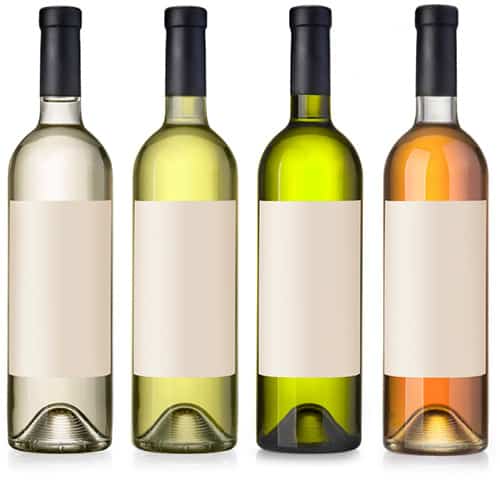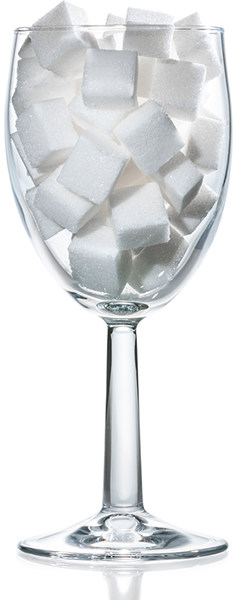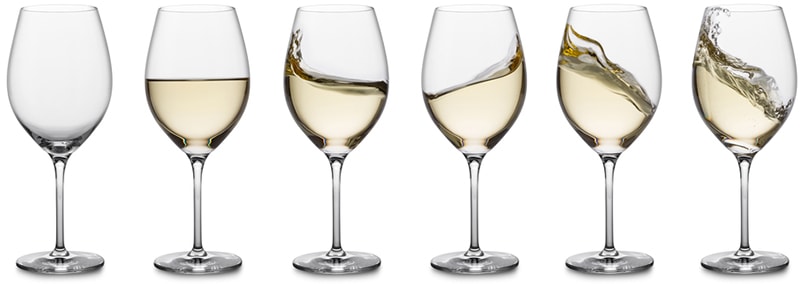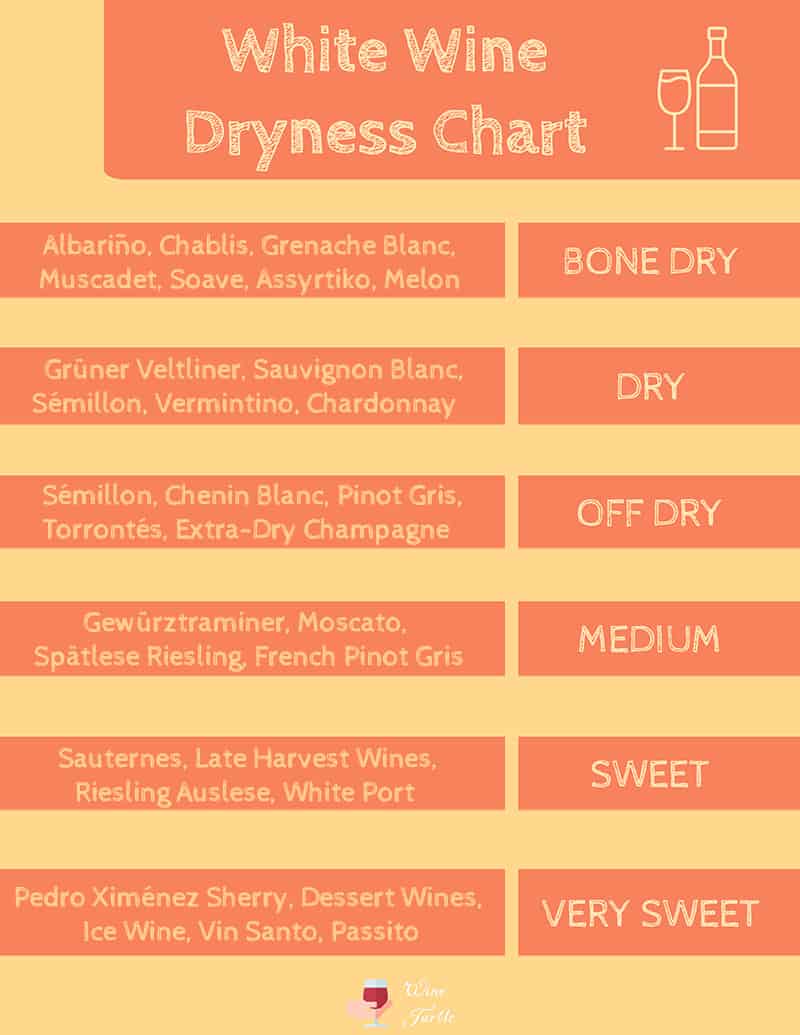The Driest White Wines: Ranking Dry White Wines
Dry and sweet wines are so contentious that many people love and hate one or the other.
But taken subjectively, each has a place on the dinner table, scratching that itch for a crisply acidic or a cloyingly sweet tipple.
Sweetness is also subjective. For some connoisseurs, only wines that meet a residual sugar threshold are sweet, while others class any wine with a sweet flavor profile – irrespective of the residual sugar – as a sweet wine.
Whichever side you are on, there's more than meets the eye with dry and sweet wines, with several factors determining subjective sweetness.
In this guide, we explore the driest white wines and ranks them from dry to sweet, helping you choose a bottle that matches your tastes.
The Difference Between Sweet and Dry White Wines
The most significant difference between sweet and dry wines is that sweet wines contain more sugar, sometimes over 200 g/L. To put that in perspective, that's a lot more than Coca Cola, which has around 106 g/L of sugar.
Importantly, reputable wines do not contain added sugar – they get their sugar as a result of the natural sugar in grapes not being allowed to ferment fully into alcohol (but there are other ways for this to happen which you can read about in our guide to sweetening wine).
Yeast turns sugar into alcohol (ethanol) during fermentation, so a shorter fermentation stops the yeast in its tracks, preserving more sugar. Sweet wines are therefore fermented for less time than dry wines.
Another by-product of this is that sweet wines typically have a significantly lower ABV than dry wines due to them containing more sugar and less alcohol.
However, there are exceptions like Muscadet, a bone-dry wine with only a 12% ABV – this is a dry white wine without much of a kick. You can also get some wines like Riesling in dry, off-dry, and sweet varieties.
What is Residual Sugar, and Why is it Important?
Residual sugar (or RS) is the sugar leftover in the wine after fermentation, an essential metric because wine dryness is measured in terms of its residual sugar.
In other words, the residual sugar in a wine determines if the wine is 'sweet,' 'dry,' or something in-between. It defines the wine’s category and the label you see when looking for wine on the shop shelf.
We measure RS in grams per liter. Here's an example - a wine with 20 grams per liter of residual sugar has 2% sweetness.
Here's how that corresponds to dryness:
A wine with more residual sugar is sweeter than one with less, although that does not always translate to how we perceive them.
Fruity flavors, and flavors that mimic treats like cola and licorice, can make an off-dry wine deceptively sweet on the palate.
Factors Affecting How We Perceive Sweetness in Wine
How we perceive sweetness in wine is down to several factors:
Here's what you need to know:
Residual sugar
More residual sugar equals a sweeter wine, and it also increases the density of the wine, coating the palate with sweetness.
As you go over 100 g/L of sugar, sweet wine can be cloyingly sweet unless it has the acidity to balance it.
Acidity
Acidity counteracts residual sugar, so a more acidic wine tastes dryer than a less acidic one, even if it has more residual sugar.
Acidity can be introduced to white wine by adding tartaric acid before fermentation, which preserves the sugar.
Tannins
Tannins create a drying sensation in the mouth and provide texture, balance, and structure to the wine, counteracting sweetness with bitterness. Tannins give the wine a snap and finish, helping offset sugar as acidity does.
While it's red wine that is known for its tannin content, white wines do contain tannins too, just in very small doses. They get their tannin from grape seeds and stems, as the skins are removed.
Bright, fruity flavors
The brighter the fruity flavors in wine, the sweeter it tastes. Flavors like red licorice, strawberries, melon, and cola give the wine a sweet edge, even without the sugar to back it up.
For instance, a dry Zinfandel can taste relatively sweet. So too can a juicy Shiraz, where big fruity flavors of black cherry and berries can be mistaken for sweetness.
Alcohol (ABV)
Alcohol and sugar do not pair. The highest ABV wines have little to no sugar after fermentation, while lower ABVs have lots of sugar left.
More alcohol equals a dryer wine, and vice versa. If you want sugar, you must sacrifice alcohol.
The exception to this rule is with sweet fortified wines. Sweet varieties of wines like Port, Marsala, and Madeira can have ABVs of around 20%.
They achieve this by interrupting fermentation prematurely with a distilled spirit. The spirit raises the alcohol content to a level that kills the active yeast (this is called fortification). The result is a sweet wine with high ABV.
Serving temperature
The lower the temperature of the wine, the less sweet it tastes unless it has extremely high residual sugar (e.g., Ice Wine).
You can make a dry or off-dry wine taste dryer by serving it at a lower temperature and vice versa.
The Difference Between Fruity Wine and Sweet Wine
Fruity wine can taste deceptively sweet by tricking the brain with sweet flavors, while sweet wine tastes sweet precisely because it has lots of sugar.
A dry, fruity wine can have subjective sweetness with flavors like strawberry, raspberry, honey, peach, and apricot, giving it the illusion of sweetness.
Sweet wines do not need fruity flavors for sweetness – they are sweet, containing significantly more residual sugar.
A wine containing more than 45 g/L is a 'sweet wine,' and some varieties contain over 160 g/L.
A Tannic Wine Doesn't Necessarily Equal a Dry Wine
The structure, texture, and bitterness of red wine are defined mainly by its tannins and, to a lesser extent, white wines.
Silky tannins wrap around flavors for balance, while robust tannins pop and bang. Whether low or high, tannins impact the subjective sweetness of the wine.
However, a tannic wine does not necessarily equal a dry wine. For example, these red wines have low tannins but are dry:
So, what makes them taste dry? The acidity – you will find that Pinot Noir, Gamay, and Grenache have medium or high acidity to counteract fruity flavors.
The bottom line - the mouth-drying sensation of tannins does not make a wine dry – only the residual sugar does. If a high-tannin wine has lots of residual sugar, it is a sweet or off-dry variety with a mouth-drying effect.
Related: How long does wine last after opening?
White Wine Dryness Chart
Check out our white wine dryness chart below to see how white wines compare. Conversely, you could call this a white wine sweetness chart!
We cover each wine in more detail, including the levels of residual sugar you can expect, in the following section.
Please note that the sweetness level of a wine can vary depending on the specific grape variety and winemaking techniques used.
This chart is meant to provide a general overview of the relative sweetness of common white wines.
White Wines Dryness Rankings
The white wine dryness chart gave a brief glimpse at the levels of sugar in common white wines.
In this section, we go into a bit more detail about each wine. Find out how much residual sugar you can expect and also what they taste like.
This list is by no means exhaustive but it gives a good idea of what to expect when it comes to dryness and sweetness for a good range of white wines.
The Driest White Wines (Bone Dry)
These are the wines with as little sugar as possible. Fermented to dryness, they are crisp and usually on the higher end of the alcohol range.
Muscadet
A light-bodied white wine from the Loire Valley of France. Contains less than 1.0 g/L and sometimes less than 0.2 g/L of residual sugar.
Despite the low sugar content, it usually has an ABV of around 12%, which is low for a bone-dry wine.
Chablis
A full-bodied white wine from Burgundy, France, produced exclusively from the Chardonnay grape. It is bone dry with less than 0.6 g/L of residual sugar. Wet stone and citrus flavors dominate the palate.
Related: There's some great value Chablis available in our guide to Costco's best white wines.
Melon de Bourgogne
A light to medium-bodied white wine produced from the Muscadet appellation in the western Loire Valley.
It is crisp and bone dry with less than 0.3 g/L residual sugar, although some Melon de Bourgogne varieties go up to 1.5 g/L.
Assyrtiko
A medium to full-bodied Greek white wine indigenous to the island of Santorini. Bone dry with a 13.5-15% ABV and less than 0.8 g/l of residual sugar. A fresh and zingy varietal with distinctive lemon and metallic flavors.
Albariño
A light-bodied white wine produced mostly in Spain and Portugal. The residual sugar is around 0.4% in bone-dry varietals and 1 g/L in dry varietals. Expect notes of lemon, lime, pear, stone, and hints of grapefruit.
Vinho Verde
A light-bodied, highly acidic white wine produced exclusively in the Vinho Verde DOC in Portugal.
It has an ABV between 9-14%, and the residual sugar ranges from 0.2 g/L to 1.5 g/L, with most varieties around 0.4%.
Soave
A light-bodied Italian white wine from the Veneto region in northeast Italy. Bone dry with less than 0.2 g/L of residual sugar.
However, the bright flavors of peach, honeydew, and sweet marjoram make it taste sweeter than it is.
Italian Pinot Grigio
A light to medium-bodied white wine adopted by the Italians from the French. It has 0.6 to 2.0 g/L of residual sugar and distinctive acidity that dries the mouth. Neutral in flavor with grapefruit, pear, and peach notes.
Learn more in our guide to Pinot Grigio.
Dry White Wines
With slightly more residual sugar than the bone dry white wines, I'd describe these wines as having a "hint" of sweetness.
Sauvignon Blanc
A light-bodied, acidic white wine from the Bordeaux region of France, containing around 2 g/L of residual sugar with a 13.5% to 14.5% ABV.
Flavors of lime, green apple, passion fruit, and freshly cut grass dominate the palate.
We discuss Sauvignon Blanc at length in our guide.
Verdejo
A light-bodied dry white wine produced almost exclusively in Spain. It is low in residual sugar, with around 1.5 g/L with high acidity for balance—a grippy and crisp wine with Meyer lemon, grapefruit, and citrus blossom flavors.
Chenin Blanc
A light-bodied, fresh white wine from the Loire Valley of France. Contains 1.5-3 g/L of residual sugar, with sweet pear, honey, and peach flavors with a dose of spice and ginger. A great option if you love dry, spicy white wines.
Vermentino
A light-bodied white wine mainly produced in Sardinia, Italy, with around 2 g/L residual sugar, although some varieties have less than 1 g/L. Citrus dominates the palate with attractive bitter notes and hints of satsumas.
Grüner Veltliner
A dry white wine produced in Austria, Germany, and Hungary, Grüner Veltliner has less than 2.0 g/L of residual sugar. Gooseberry, honey, lemon, lime, and nectarine flavors give it a lush sweetness despite its dry profile.
Off-Dry White Wines
These off-dry white wines bump up the sugar content once more. Though I wouldn't consider the wines on the lower end of the scale sweet, they're definitely more approachable for somebody new to wine than drier varieties.
Chardonnay, for example, can range hugely on the residual sugar scale, from 10g/L to 36g/L.
Sémillon
Sémillon is a medium-bodied white wine primarily made in France and Austria. Off-dry varietals have around 7-8 g/L residual sugar but can go as high as 10g/L. Flavors of lemon, apple, pear, and green papaya dominate the palate.
Trebbiano
Trebbiano is a light and delicate white wine with floral notes, 5-13 g/L of residual sugar, and an ABV between 11.5-13.5%. It originates from the South-Eastern Mediterranean and is mainly produced in the Abruzzo region of Italy.
Dry Riesling
An aromatic white wine native to Germany, Riesling is available in dry, off-dry, and sweet varieties.
Dry Riesling is off-dry by traditional standards, with 9-15 g/L residual sugar and bright acidity for excellent balance.
We recommend some lovely Riesling to try in this guide.
Viognier
A medium to full-bodied white wine, Viognier is like Chardonnay but is more aromatic with rich mango and honeysuckle notes. It has 7-17 g/L of residual sugar with low acidity, giving it a distinctively sweet profile.
Chardonnay
Chardonnay is the world's most popular white wine, with off-dry varietals having 10-36 g/L residual sugar.
The high residual sugar gives it a full mouthfeel, while moderate acidity helps balance apple, pear, apricot, and papaya notes.
We recommend some excellent Chardonnay to try that won't break the bank in our latest guide.
Sweet White Wines
Things are ramped up significantly in the sweet wine category. If you're not a fan of desserts then sweet wines like these are probably best avoided.
Sweet Riesling
Sweet Riesling typically has 50-150 g/L of residual sugar, with varieties exceeding 100g/L classed as dessert wines. Some varieties go up to 220 g/L, offset by moderate to high acidity and a crisp finish. You can expect fruity, tropical flavors.
Don't miss our guide to budget Riesling if you're looking for an entry point into this gorgeous wine.
Moscato d'Asti
Sweet Moscato ranges from 70 g/L to 300 g/L of residual sugar. Moscato d’Asti, a light frizzante, is the original wine of Piedmont, Italy, with 90-120 g/L. High acidity and peach, apricot, and Meyer lemon notes give it excellent balance.
Ice Wine
Ice Wine is a dessert wine produced from grapes frozen on the vine, causing a high concentration of natural sugar. You can expect 180 to 350 g/L of residual sugar, making this the sweetest wine you can buy.
We've got a great guide on sweet white wines if you've got a sweet tooth!
Our Recommended Really Dry White Wines
If you're looking for a delicious dry white wine to try then you're in the right place!
We recommend a great value Albariño, a stunning Assyrtiko, and a slightly extravagant Chablis!
Under $20 - Bodega Garzón Uruguay Reserve Albariño 2021
Bodega Garzon Uruguay Reserve Albariño is a bone-dry white with bright peach, apple, melon, and pear flavors.
Notes of citrus, lime, and grapefruit give it a zesty profile, while a stone and lemongrass finish twists the tongue.
We love this wine's peachy aroma and sharp, lasting finish. It goes beautifully with seafood risotto, fish tacos, oysters, and gouda.
Under $35 - Jim Barry Assyrtiko 2018
Jim Barry Assyrtiko brings Greek authenticity to your table from Australia! It is the country's first Assyrtiko, with citrus blossom, Meyer lemon, and honeydew melon notes with a fine texture and a saline finish.
Wet slate and citrus rind on the nose give this wine a refreshing, mineral edge. It's perfect with fried seafood, shellfish, and feta salad.
Under $100 - William Fevre Chablis Montmains Premier Cru 2020
William Fevre Chablis Montmains Premier Cru is a medium-bodied Chardonnay from Bourgogne, France.
It's bone dry with high acidity and balanced flavors of grapes, citrus, lemon, green apple, and lashings of minerals.
This authentic Chablis wine is impressively robust, complementing garlic and onion dishes, barbeque seafood, and smoked fish.
Recommended Food Pairings for Really Dry White Wines
Bone dry and dry white wines generally pair best with light meats, seafood, shellfish, chicken, pork, and grilled/roasted vegetables.
The more acidic the white wine, the better it pairs with fatty foods like salmon, roast pork, and salad with feta cheese drizzled in olive oil.
Off-dry white wines have enough residual sugar to complement moderately spicy dishes, with Cajun and Thai food pairing exceptionally well.
You should avoid white wine with red meat, stinky cheeses, red sauces, and game meat – these pair best with red wine.
What's your favorite dry white wine? Do you have a recommendation you'd like to share? Let everyone know down in the comments section!







